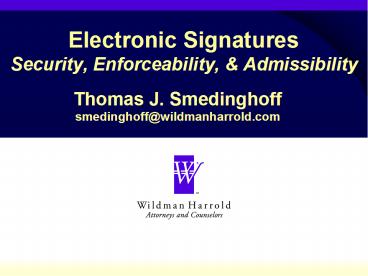Electronic Signatures Security, Enforceability, - PowerPoint PPT Presentation
1 / 17
Title:
Electronic Signatures Security, Enforceability,
Description:
Uniform Electronic Transactions Act (UETA) ... Central African Republic, Lebanon, and Senegal signed to date. Signing ceremony July 2006 at UN ... – PowerPoint PPT presentation
Number of Views:60
Avg rating:3.0/5.0
Title: Electronic Signatures Security, Enforceability,
1
Electronic SignaturesSecurity, Enforceability,
Admissibility
- Thomas J. Smedinghoff
- smedinghoff_at_wildmanharrold.com
2
Key E-Signature Laws
- United States
- Uniform Electronic Transactions Act (UETA)
- Electronic Signatures in Global and National
Commerce Act (E-SIGN) - European Union
- Electronic Signatures Directive
- International Treaty
- 2005 United Nations Convention on the Use of
Electronic Communications in International
Contracts (UN
E-Contracting Convention)
3
The UN E-Contracting Convention
- Negotiated 2002-2005 at UNCITRAL
- Approved by United Nations in November 2005
- Currently open for signature and ratification
- Central African Republic, Lebanon, and Senegal
signed to date - Signing ceremony July 2006 at UN
- Applies to B2B international transactions
- Non-regulatory approach to
- remove barriers to international e-commerce
- provide legal certainty
4
E-Contracting Convention Summary
- Legal recognition of e-commerce
- Cant deny enforceability due to electronic form
- Definition of e-signature
- E-records and e-signatures satisfy
- Writing signature requirements
- Originality requirement
- Recognition of automated contracts
- Rules for time and place of sending and receipt
of messages - Rules for human input errors
- Freedom of contract
5
How Should We Sign an Electronic Document?
Options (1)
- Digitized handwritten signature
- e.g.,
- Typed name of a person
- e.g., /s/ James Bond
- Secret code for a person
- e.g., a PIN number 007
- Any symbol
- e.g., X, ?
- A mouse click
- e.g.,
6
How Should We Sign an Electronic Document?
Options (2)
- Biometric data
- A fingerprint
- A retinal scan
- A voice print
- A digital signature
- E.g. iQCVAwUBMARo7vgyLN8bw6ZVAQF6ygP/fDnuvdAhGlDW
sSMXUIRMuNHYzdZ00cqkDb/Tc2DuhuEa6GU03AgZY8K9t5r9i
ua34E68pCxogUz009b1OcjNt6o704Z3j1YY9ijYM8BWNaSp9
L2W4nUuWBdIyIWyol/2PjjRVNZEtqtSRQnPEpJ2IHtz9iGovHf
0SqhSZKZs
7
E-Signatures
- Are We Asking the
- Wrong Question?
8
But How You Sign is Not the Key IssueThe Real
Issues are . . .
- Identifying who signed (or
who clicked) - Even an X on paper can comply with legal
signing requirements - Ensuring document not altered
- In other words, is the signed document
trustworthy? - Security -- the missing element in
e-signature discussions
9
Key Requirements for Trust
- Authenticity
- Who really signed the document?
- Integrity
- Has the document/signature been altered?
- Since it was signed?
- Since it was sent-- e.g., in transmission?
- Since it was received --e.g., while in storage?
- Nonrepudiation
- Evidentiary issues ensuring the signer cannot
- Falsely deny signing the document
- Falsely deny the contents of the document
10
Comparison of Requirements for a Valid
E-Signature
- U.S.
- Symbol or process
- Attached
- Intent
- ________
- ________
- EU
- Data
- Attached
- _________
- Method of authentication
- _________
- UN
- Method
- _______
- Intent
- Identify signer
- Reliability
11
The UN Approach
- Long history of signature issue development at
UNCITRAL - 1992-1996 Initial focus on identity and
approval - 1997-2001 Shift to PKI focus
- 2002-2005 Shift to reliability appropriate to
the transaction - Ultimate focus on a reliable method to
establish identity and intent - Security is required for enforceability!
- Doesnt even use term signature
- Option to prove up non-reliable signature
12
E-Signatures Deemed Reliable?
- The standard formulation
- Unique to the signer
- Capable of independent verification
- Under the signers sole control
- Linked to the document signed such that any
alteration of document or signature is
detectable - But is this necessary or appropriate?
- UNCITRAL moved away from this approach
13
Establishing Trust in a Signature
- Trust can be derived from the type of signature
- E.g., using a PKI digital signature for signing
and/or digitally locking the document - Trust can be derived from the process used
- E.g., careful authentication of the signer before
he signs or clicks - E.g., carefully controlling access to the signed
document
14
E-Signature Security Why Should You Care?
- The level of security may determine
- Validity of a signature or assent
- Enforceability of a document
- Authenticating the source
- Verifying the integrity
- Validity of a transaction
- Admissibility of electronic evidence
15
Security as a Precondition to Admissibility
- An interesting recent case
- American Express v. Vinhee (9th Cir.)
- Electronic records not admissible without
evidence of adequate security
16
The Key to Electronic Signatures and
E-Transactions
- PROCESS and
- SECURITY!
17
Further Information
- Thomas J. Smedinghoff
- Wildman Harrold LLP
- 225 West Wacker Drive
- Chicago, Illinois 60606
- (312) 201-2021
- smedinghoff_at_wildmanharrold.com































